11.7 The Futurist Movement in Art: Selected Images and Connected Texts
The City that Inspired the science fiction film Blade Runner:
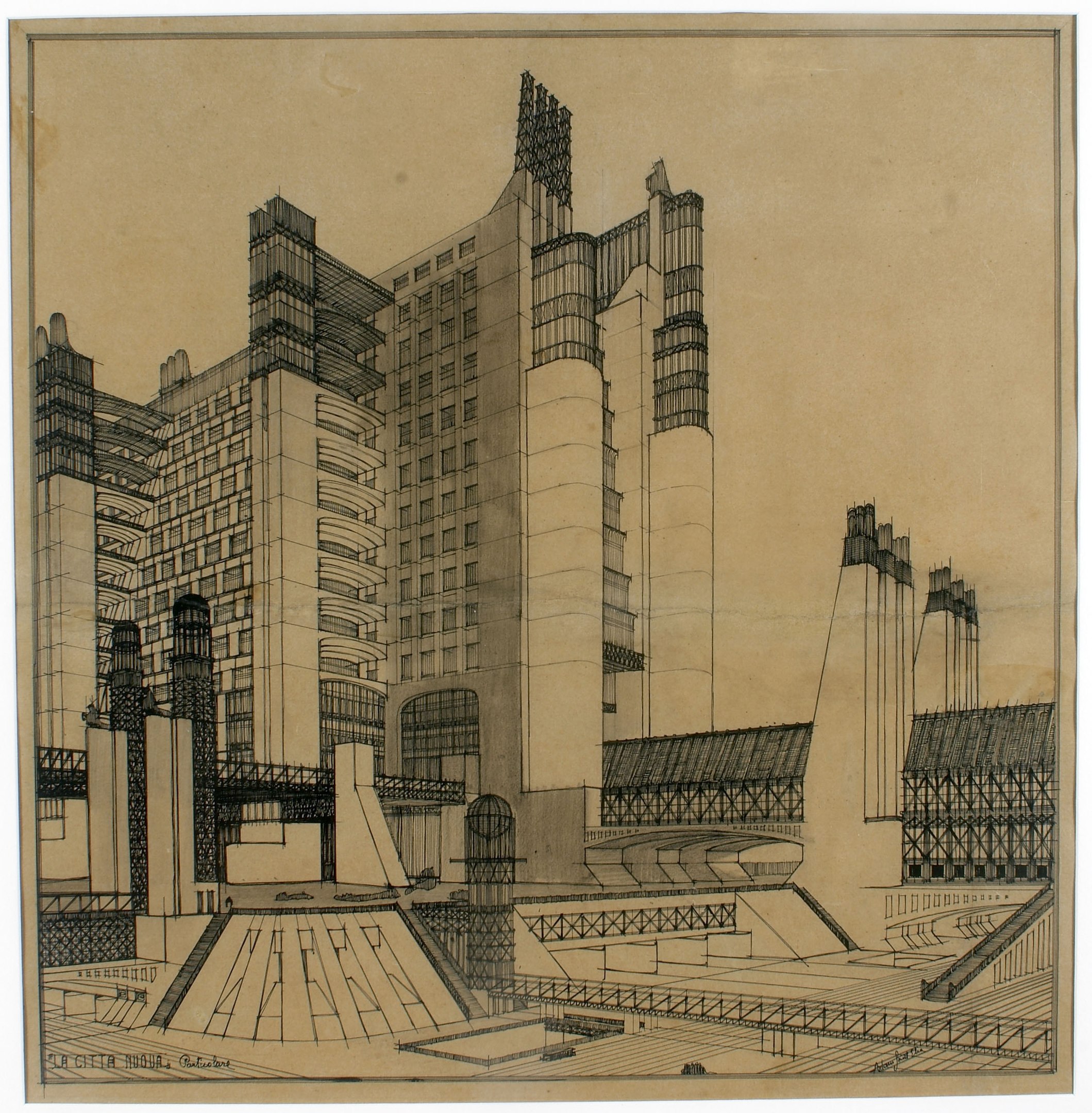
Courtesy: By Antonio Sant’Elia – Utopie metropolitane, la mostra (in Italian). Style & Design. l’Espresso (2013-03-28). Retrieved on 2013-04-01., Public Domain, https://commons.wikimedia.org/w/index.php?curid=25399724
The futurist art images and related texts that are in this section are meant to complement the study of science fiction texts. Learners can extend their insights and understanding about some of the sociocultural factors that influenced science fiction writing and futurist art movements.
The Futurists were a group of artists and designers who rejected past artistic traditions of depictions of the human figure, sentiment and emotion, romance, myth, and history the artistic and social movement of Futurism occurred during the 1909-1914 time period and predominantly involved Italian and Russian painters. The weight of the past was viewed as oppressive and stagnating. A “cleansing” would enable the create spirit to thrive in a machine age. Traditional art galleries and museums were viewed as cultural wastelands. The new order should be celebrate innovation. The futurists exalted the beauty of speed, machines, engineering, and technology. Inspired by the Italian poet Filippo Tomaso Marinetti (1876-1944) the futurists adapted techniques from cubists and post-impressionist painters to redefine the style and content of art (Jansen and Jansen, 2005). This unique and imaginative new dimension of art was also influenced by Albert Einstein’s theory of relativity which reconceptualised time, space, and energy.
Artists like the Italian futurist painter Umberto Boccioni and the Russian artist Liubov Popova (1889-1924) featured dynamic images that youth, energy, and imagination. Trains, cars, airplane, and the rise of large industrial cities like London became symbols of the new age that would be governed by a military elite. There was an aggressive and destructive element to the Futurist themes found in Marinetti’s Manifesto that served to inspire and embolden fascist and military dictatorship that rose during the early 20th century. Aldous Huxley’s Brave New World and George Orwell’s 1984 were critical satires that exposed the destructive capacities of totalitarian societies. After the devastating effects of World War I (1914-1918), a return to more traditional art forms surfaced. Martinelli continued to “restart” a second generation of futurist thinkers and artists in Britain, the United States, and Japan. Futurist art influenced styles of the Art Deco movement, Dada, and German Expressionism.
Learning Objectives
- Examine the following artistic futurist visions and write down your own impressions of the meaning in each image. What message is the artist sending about the future? Does the image speak to our world in the present? Is the artist’s message positive, negative, or ambiguous?
- Find and describe two or three art images in this section that you find compelling.
- What would your city of the future look like? What are your thoughts about the future? Draw and write about your city of the future.
For more information about Futurism please open the link here.
To read about Antonio Sant’Elia, the Italian architect who inspired the city in the film Blade Runner please open the link here.
Learning Resources on Futurist Art, The Tate Britain.
Futurist Themes and Terminology, The Tate Britain.
Futurist Feelings Handout, The Tate Britain.
The Art Story essay on Futurism, The Tate Britain.
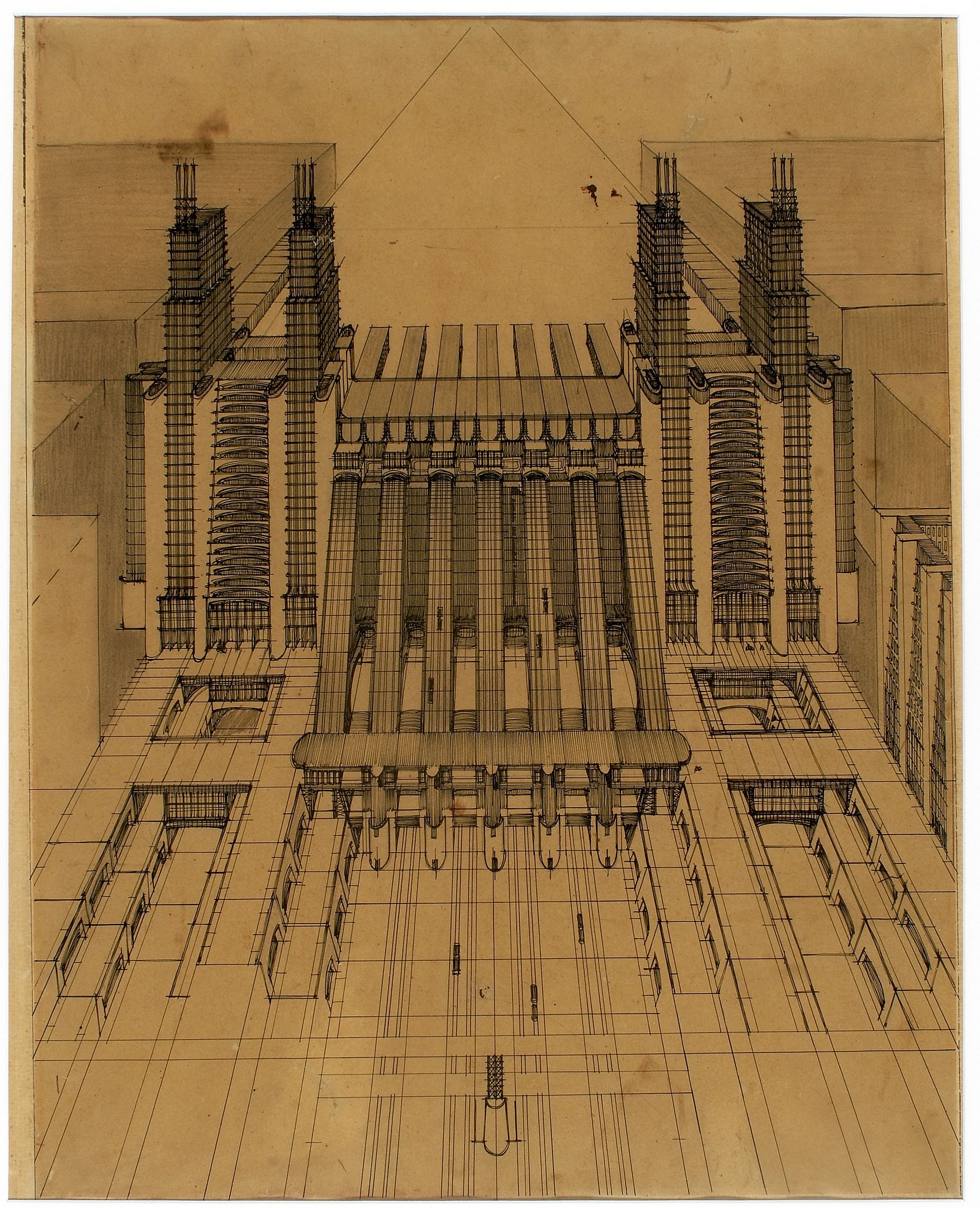
Courtesy: By Antonio Sant’Elia – Utopie metropolitane, la mostra (in Italian). Style & Design. l’Espresso (2013-03-28). Retrieved on 2013-04-02., Public Domain, https://commons.wikimedia.org/w/index.php?curid=25402603
Visions of the Future depicted in Sant’Elia’s work
Reed Enger (2022) writes that in his short life Antonio Sant’Elia as a visionary “prophet” of an ominous industrial future. He explains: “Sant’Elia’s drawings establish a monumental scale: towering, interconnected urban plinths that hum with energy. As with many of the futurist and expressionist architects at the turn of the century, most of Sant’Elia’s designs were ever built. But his visions appear in science fiction films like Fritz Lang’s Metropolis, Ridley Scott’s Bladerunner, and the sweeping worlds of the Halo games, and take physical form in the functional architecture of modern power plants and hydroelectric dams.” (Enger, Art History Project, 2022).
For more information about cities in art please open the link here.
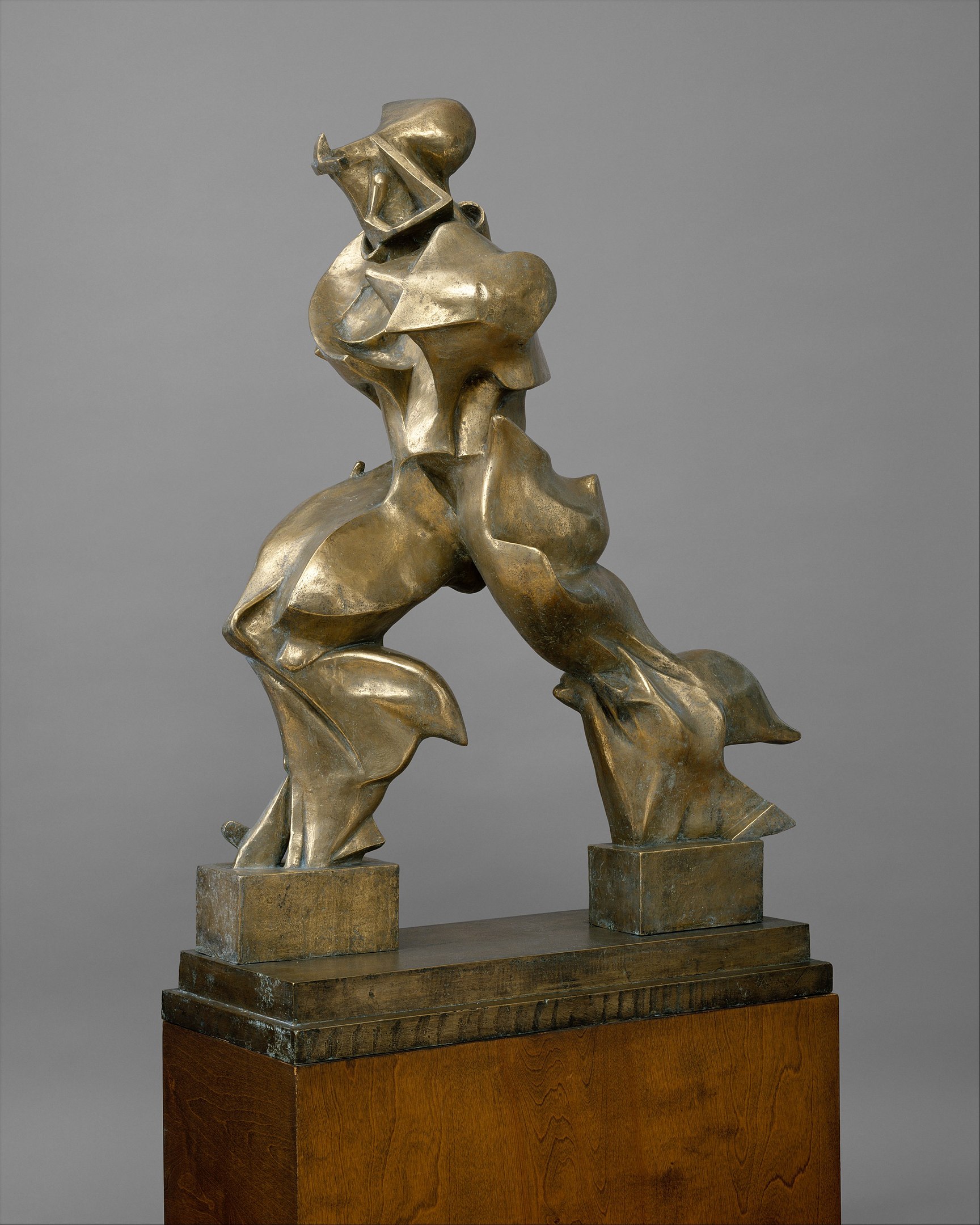
Courtesy: Bequest of Lydia Winston Malbin, 1989. “https://www.metmuseum.org/art/collection/search/485540” is licensed under CC0 1.0.
Metropolitan Museum of Art, New York City Note about Boccioni’s Forms of Continuity in Space:
“The Futurists’ celebration of the fast pace and mechanical power of the modern world is emphasized here in the sculpture’s dynamism and energy. The figure’s marching silhouette appears deformed by wind and speed, while its sleek metal contours allude to machinery. World War I broke out the year after Boccioni created this work. Believing that modern technological warfare would shatter Italy’s obsession with the classical past, the Futurists welcomed the conflict. Tragically, Boccioni was killed in action in 1916, at the age of thirty-four.”
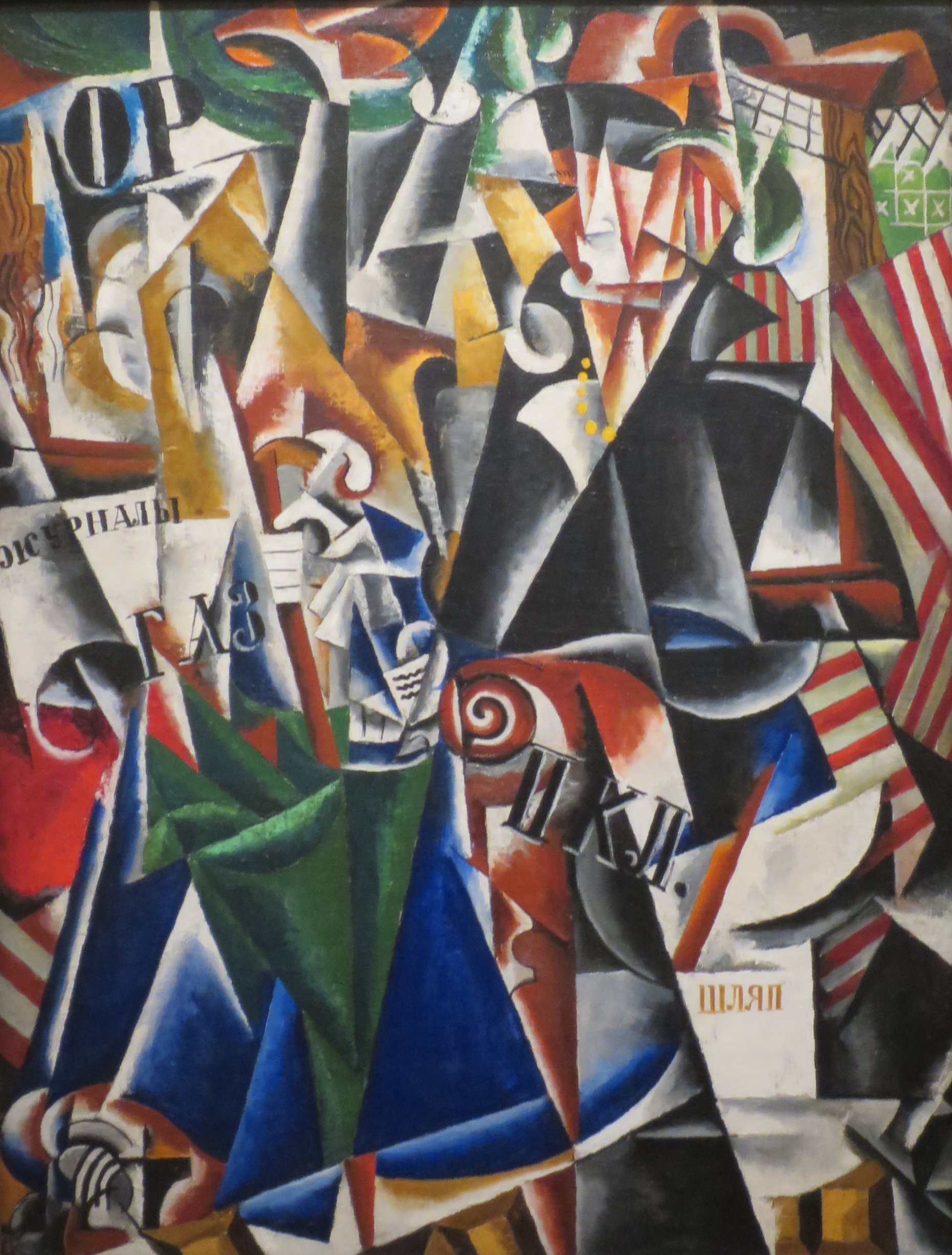
Courtesy: By Lyubov’ Popova – Own work, Public Domain, https://commons.wikimedia.org/w/index.php?curid=38177426
Norton Simon Museum of Art Note about Liubov Popova
“As a young woman from a prosperous Russian family, Liubov Popova traveled throughout Europe to develop her talents as a painter. She worked constantly, studied the Old Masters, and enrolled in the Parisian Académie de la Palette, where her teachers included Jean Metzinger, an early practitioner of Cubism. This abstracted composition suggests the speed and sense of dislocation associated with modern transport, and seems to include an oblique self-portrait in the central figure: a woman wearing a yellow necklace and high-collared cape who reads a magazine or newspaper in her seat on a train, grasping a green umbrella in one gloved hand. Snatches of words (including the Russian terms for “gazette,” “hat,” “2nd class,” and the roar of the train) vividly convey the sights and sounds of locomotive travel. With her use of found text, fragmented forms, and shapes rhythmically repeated to create a sense of acceleration, Popova assimilated both French Cubism and Italian Futurism in a uniquely Russian hybrid known as Cubo-Futurism.” (Norton Simon Museum of Art, Pasadena, California).
To learn more about Lyubov Popova please open the link here.
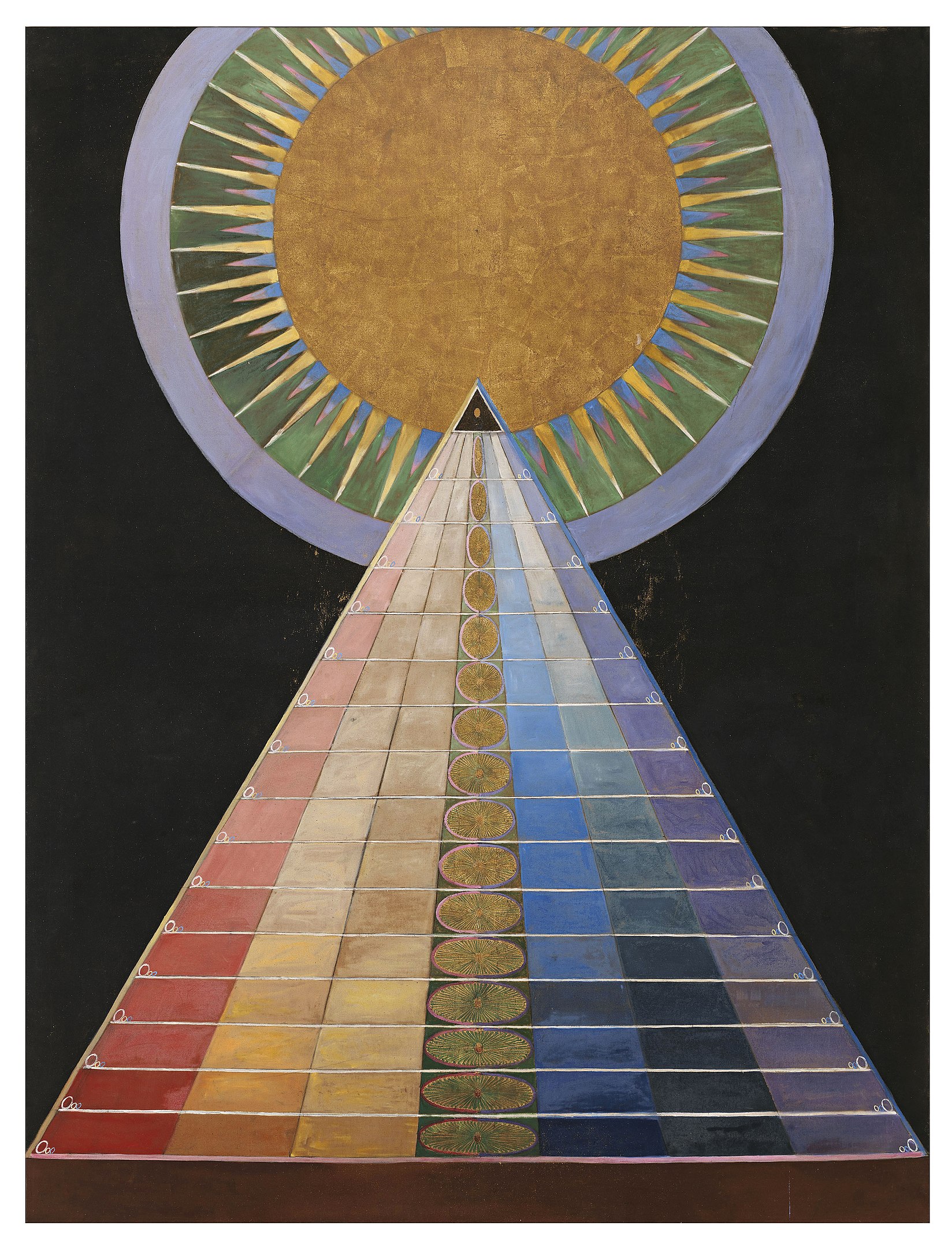
Courtesy: By Hilma af Klint – http://www.kunstkritikk.no/kritikk/hilma-af-klint-diagram-artist/, Public Domain, https://commons.wikimedia.org/w/index.php?curid=38482152
To read “Hilma af Klint: The Enigmatic Vision of a Mystic” please open the link here.
To read more about Hilma af Klint please open the link here.
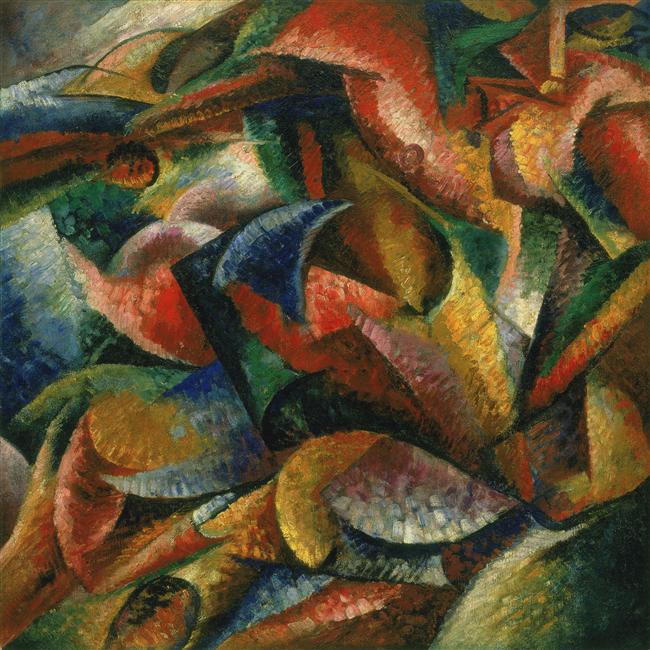
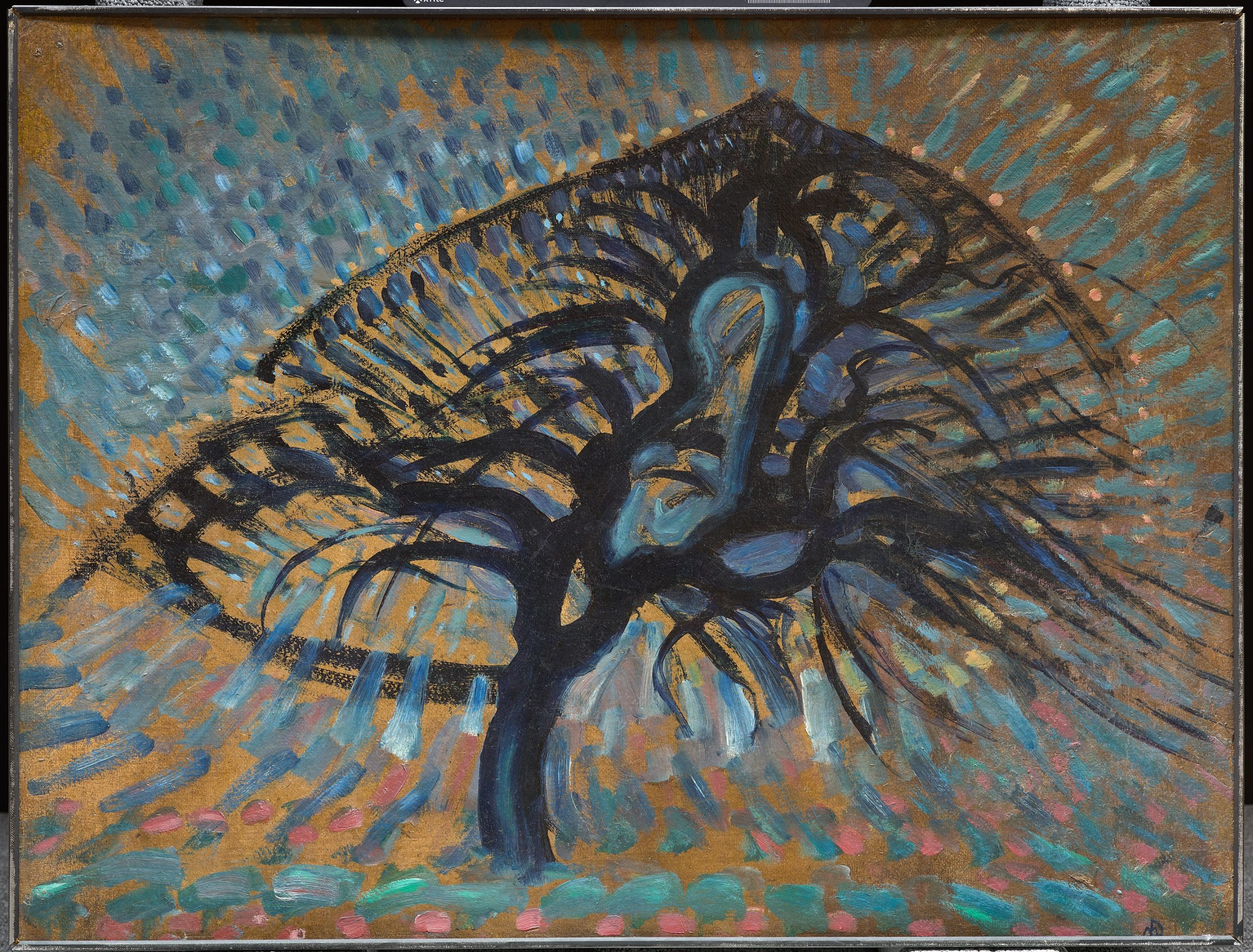
Courtesy: By Piet Mondrian – Dallas Museum of Art, Public Domain, https://commons.wikimedia.org/w/index.php?curid=85072090
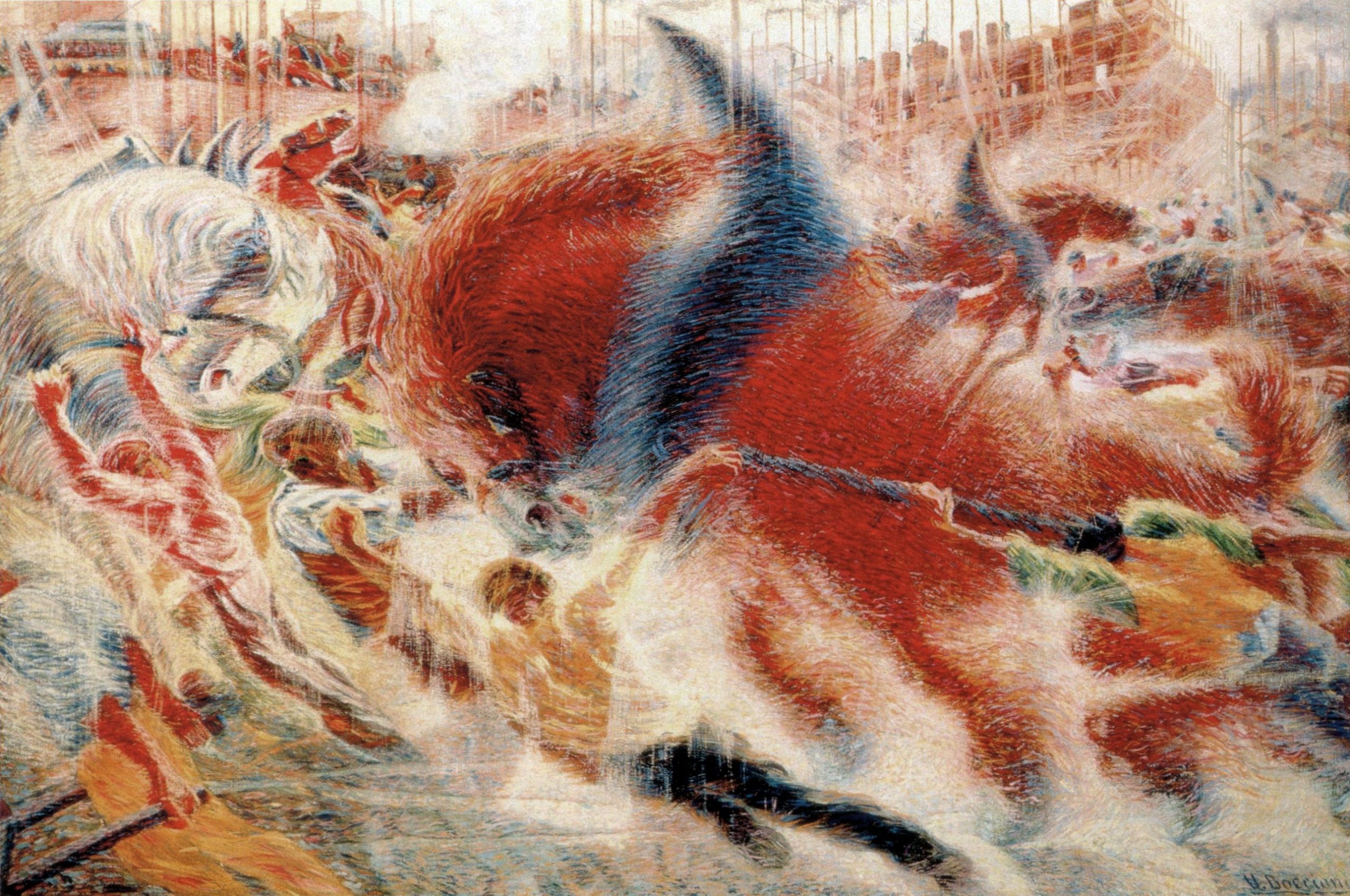
Courtesy: By Umberto Boccioni – Moma.org, Public Domain, https://commons.wikimedia.org/w/index.php?curid=24439259
Art in Context: The Futurists.
Britannica essay on Futurism.
Essays about Futurism can be found here and here.
The Guggenheim collection of Futurist Art Exhibitions.
The Metropolitan Museum Timeline Art of Futurist Art.
Innovative and Abstract Art in the Early 20th Century
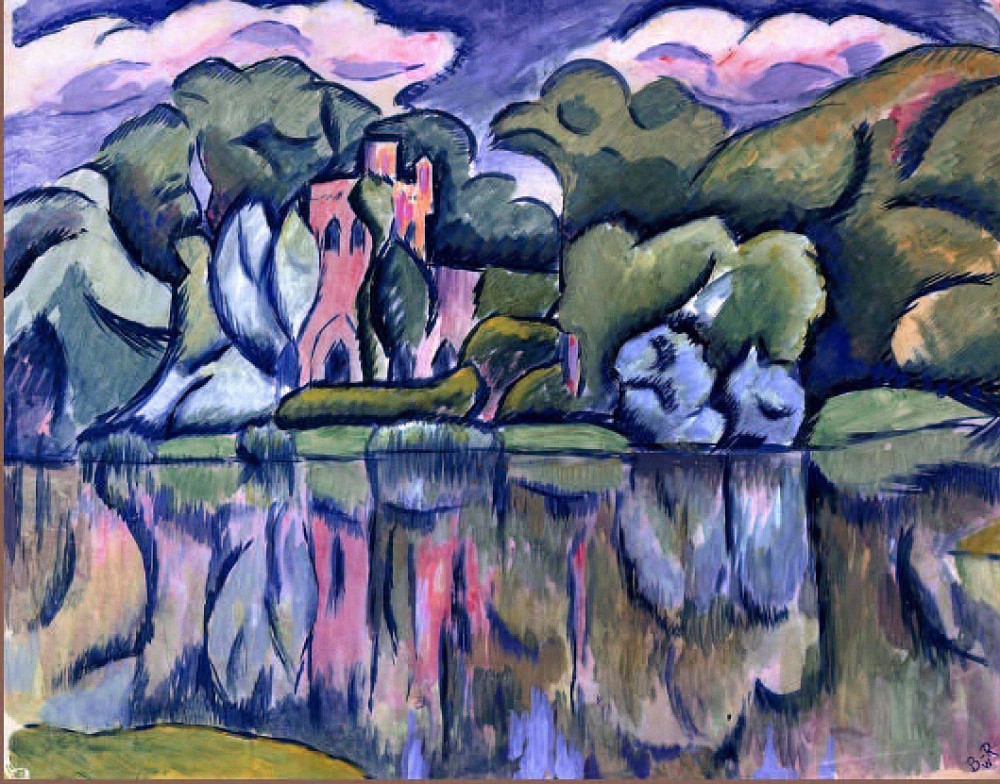
Courtesy: By Vladimir Baranov-Rossine – the-athenaeum.org, Public Domain, https://commons.wikimedia.org/w/index.php?curid=79445517
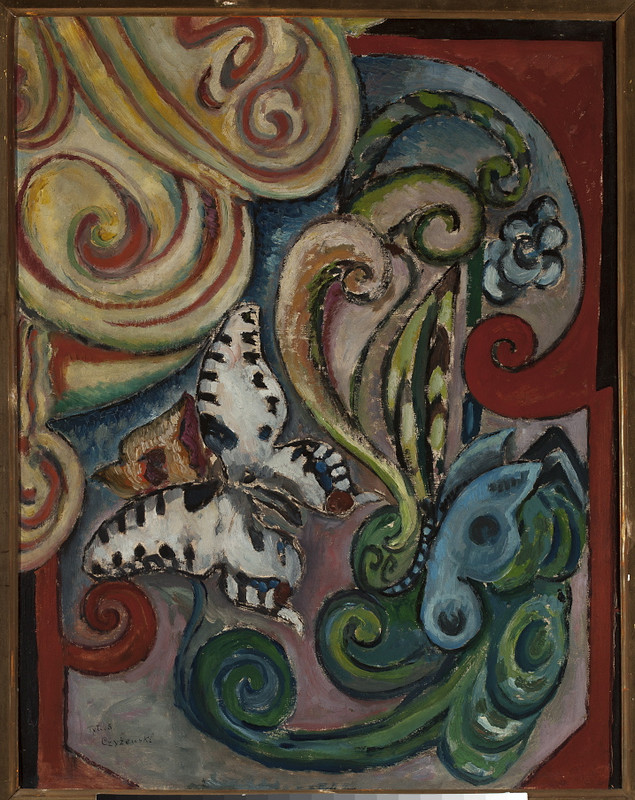
Courtesy: By Tytus Czyżewski – National Museum in Warsaw, Public Domain, https://commons.wikimedia.org/w/index.php?curid=99175763
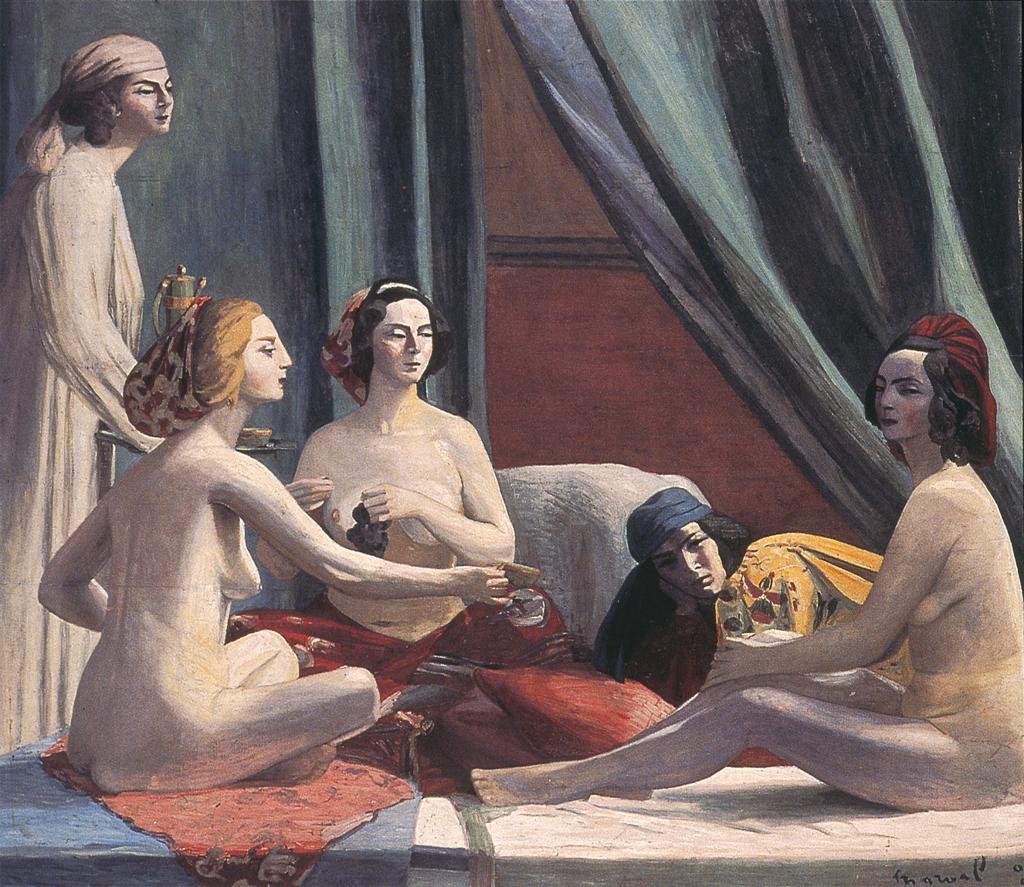
Courtesy: By Jacqueline Marval – https://bonjourparis.com/art/the-marvelous-madame-marval-a-woman-artist-among-the-fauves/, Public Domain, https://commons.wikimedia.org/w/index.php?curid=24512875
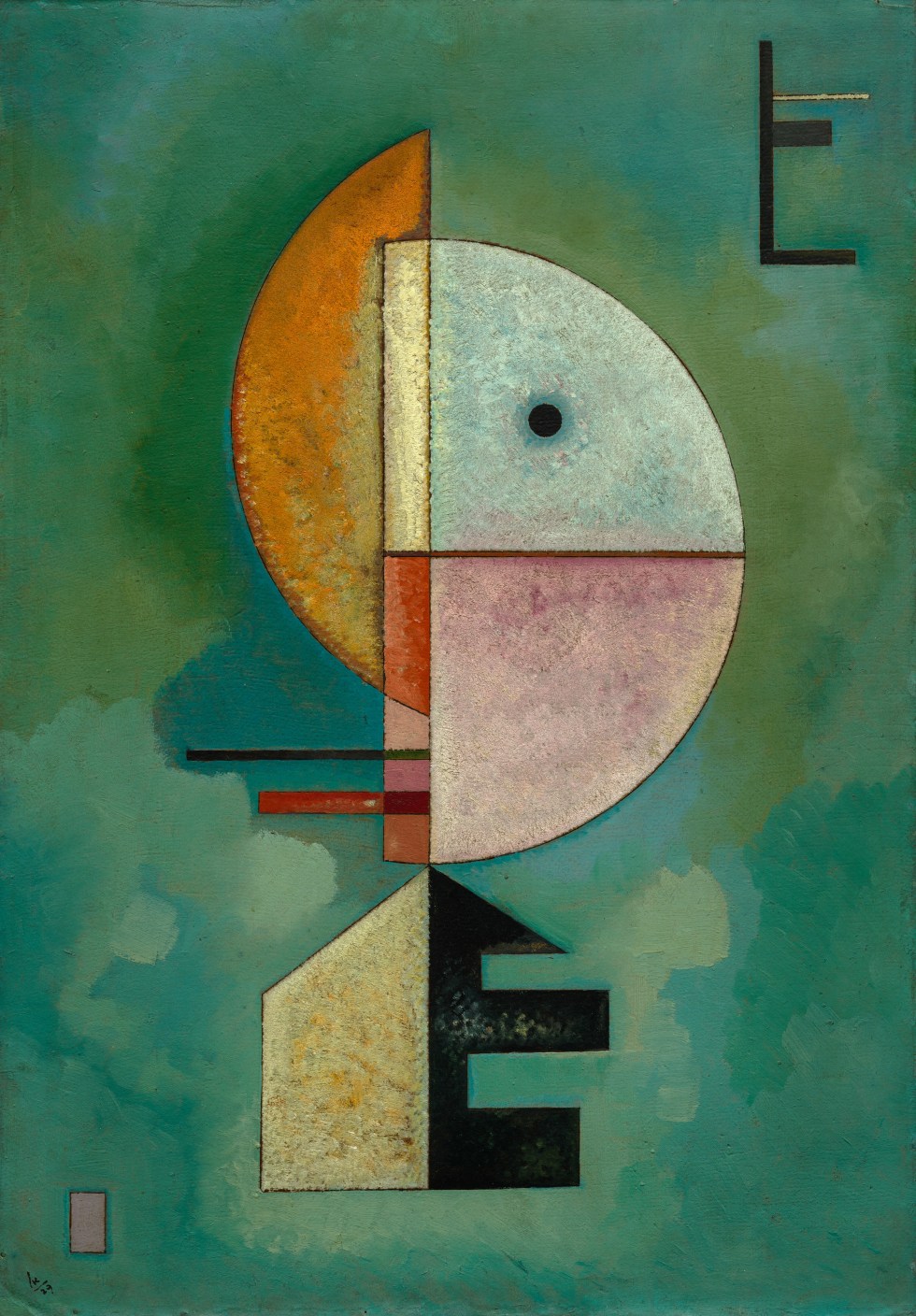
Courtesy: By Vasily Kandinsky – Guggenheim Collection, Venice, Public Domain, https://commons.wikimedia.org/w/index.php?curid=65662620
To learn more about the art of Vasily Kandinsky please open the link here.
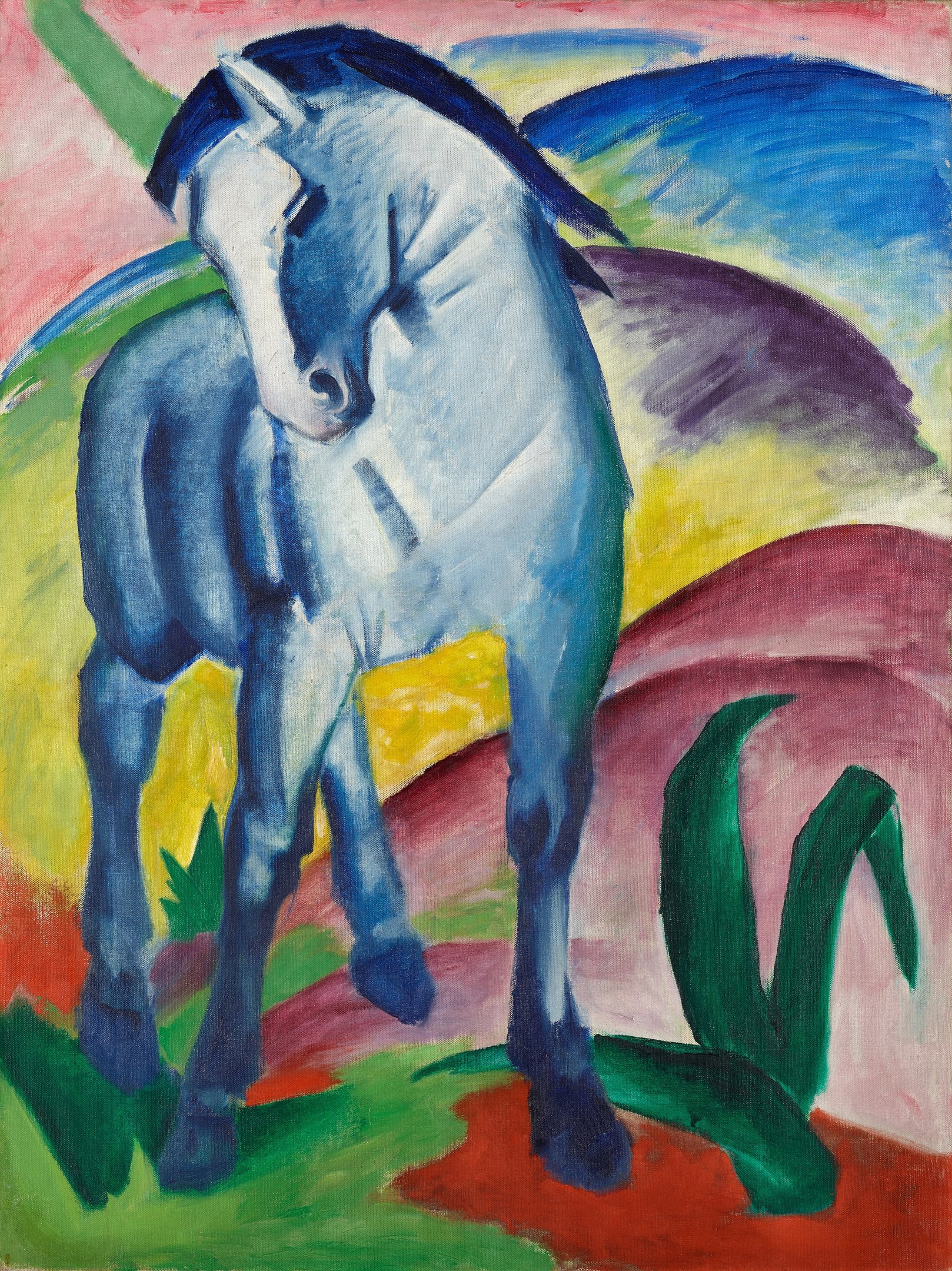
Courtesy: By Franz Marc – ZAFpPn_oQwEIwQ at Google Cultural Institute, zoom level maximum, Public Domain, https://commons.wikimedia.org/w/index.php?curid=29848131
To read an essay about Paul Klee please open the link here.
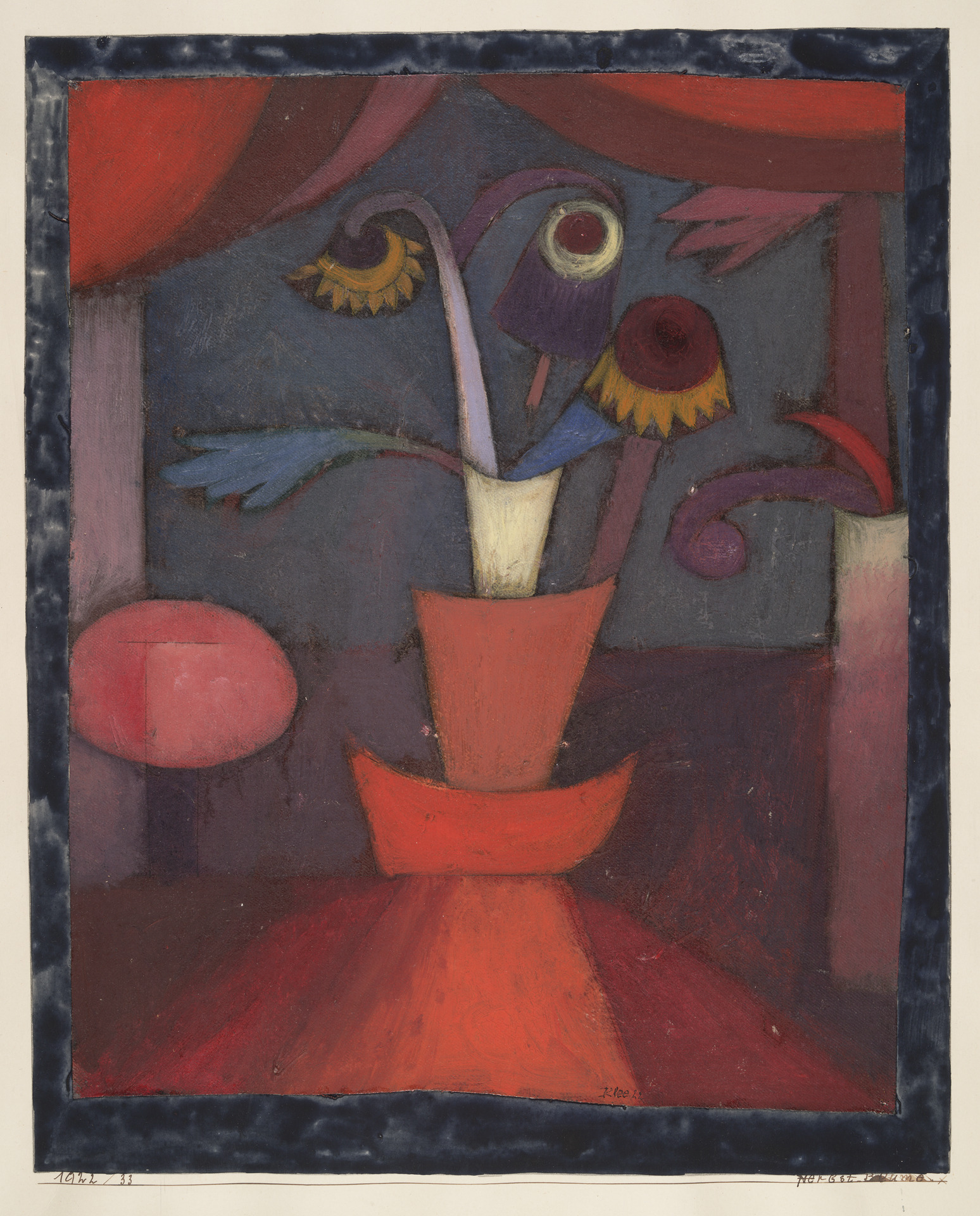
Courtesy: By Paul Klee – https://artgallery.yale.edu/collections/objects/51111, Public Domain, https://commons.wikimedia.org/w/index.php?curid=80485233
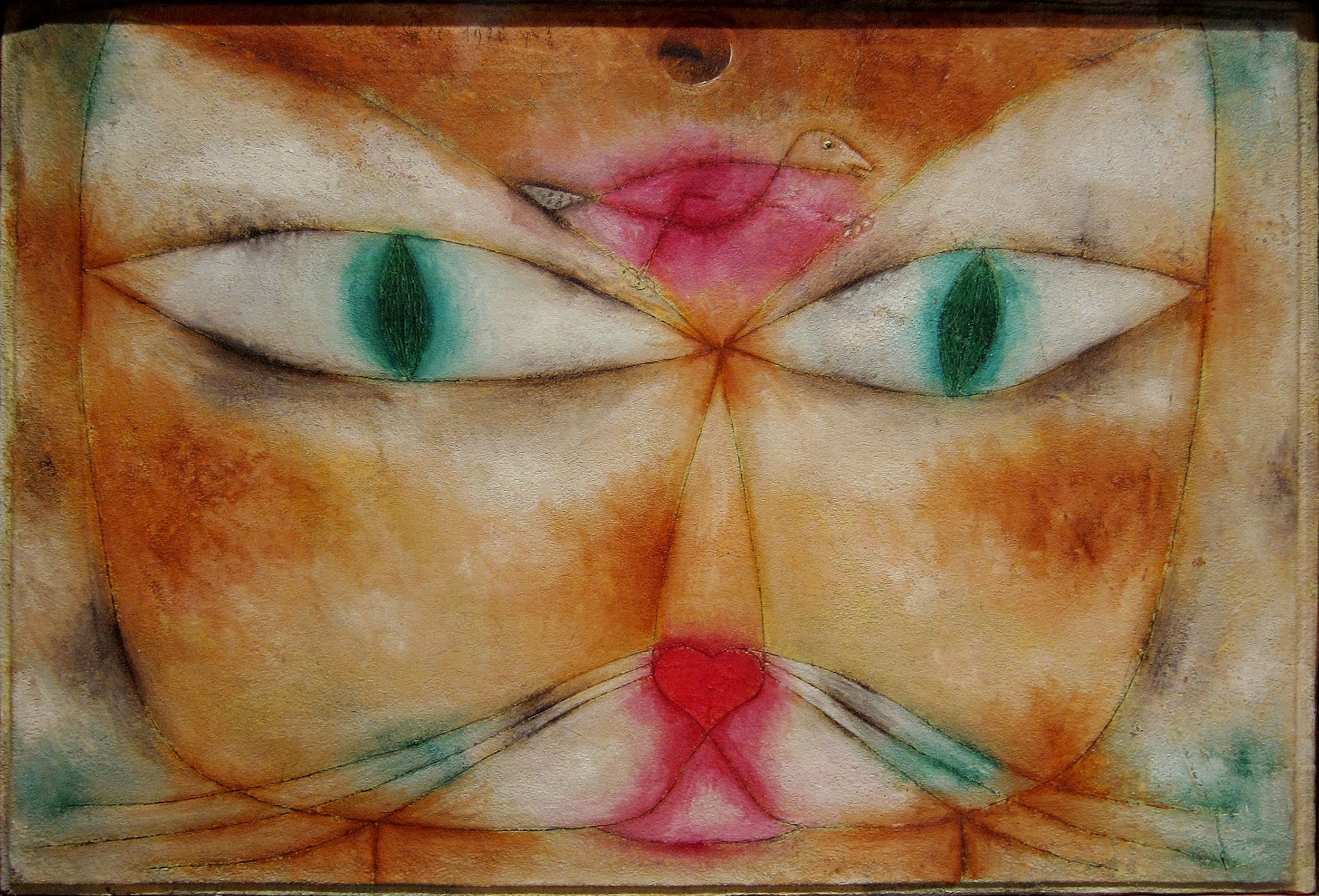
Courtesy: By Paul Klee – Own work, Public Domain, https://commons.wikimedia.org/w/index.php?curid=19729247
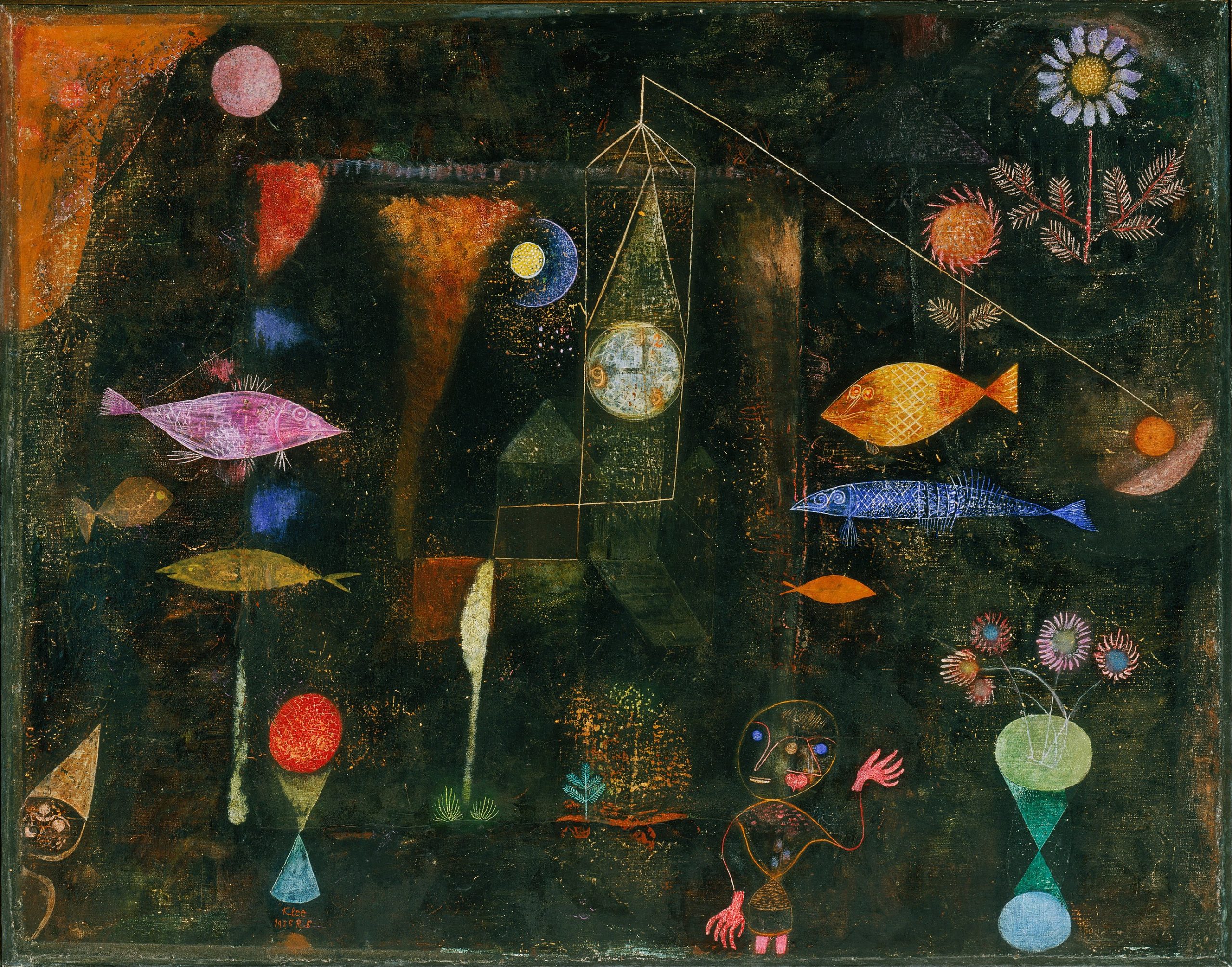
Courtesy: By Paul Klee, Swiss, 1879 – 1940 (1879 – 1940) – Artist/Maker (Swiss)Born in Münchenbuchsee, Switzerland. Died in Muralto, Switzerland.Google Art Projectでのアーティストの詳細 – YwG0HRupAcHutA at Google Cultural Institute maximum zoom level, Public Domain, https://commons.wikimedia.org/w/index.php?curid=22627282
Daily Art Magazine Note about “Fish Magic” by Paul Klee
“Fish Magic is a mysterious and very fascinating work by Swiss-born German artist Paul Klee, a painter who balanced on the verge of a few modern art movements such as Expressionism, Cubism, and Surrealism. The traces of all of them are present within this oneiric, almost fluorescent painting (but not really, read why!). It is crowded with weird, aquatic creatures which seem to flow out from the deep darkness to appear to the viewer for just a moment before vanishing again into the depths of Klee’s magical world.” (Kate Wojtczak, Daily Art Magazine, 2022),
Apocalyptic Visions of the Future through an Artistic Lens
Many works of speculative and science fiction highlight a world adversely impacted by climate change, depleted resources, and the rise of authoritarian and totalitarian governments. A loss of spiritual values, chaos, and the struggle to survive ensues. W.B. Yeat’s “The Second Coming” exemplifies the growing anxieties of a world in turmoil at the turn of the century. “The centre cannot hold” and “things fall apart” are alarm bells warning of ongoing war and imminent disaster if destructive capacities cannot be transformed. Research more about the artist’s life and summarize your findings. Think of science fiction novels and stories that feature apocalyptic or post-apocalyptic setting. How do the writers describe the settings? Cormac McCarthy’s (2006) The Road, Margaret Atwood’s (2003) Orynx and Crake, and Octavia Butler’s (1993) Parable of the Sower series are examples of novels set in post-apocalyptic times. Which works of art could be used to represent the settings and overall mood and tone of the work? Do any of the artists have an optimistic vision of the future? What needs to change in order to ensure life-centred values?
“The Second Coming” by William Butler Yeats (1865–1939)
Apocalyptic Visions of the World
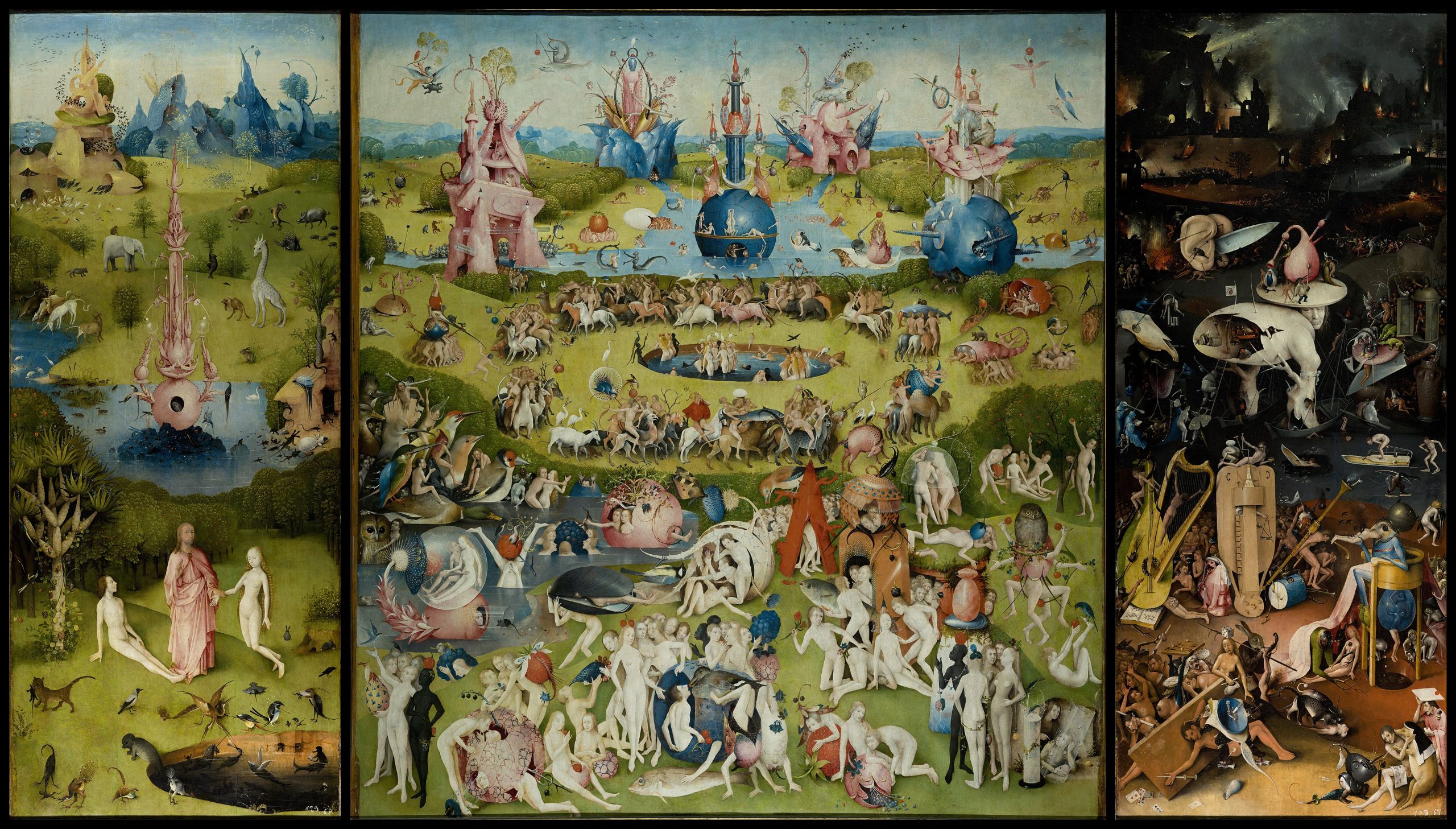
Courtesy: By Hieronymus Bosch – The Prado in Google Earth: Home – scaled down from 8 level of zoom, JPEG compression quality: Photoshop 10., Public Domain, https://commons.wikimedia.org/w/index.php?curid=22605738
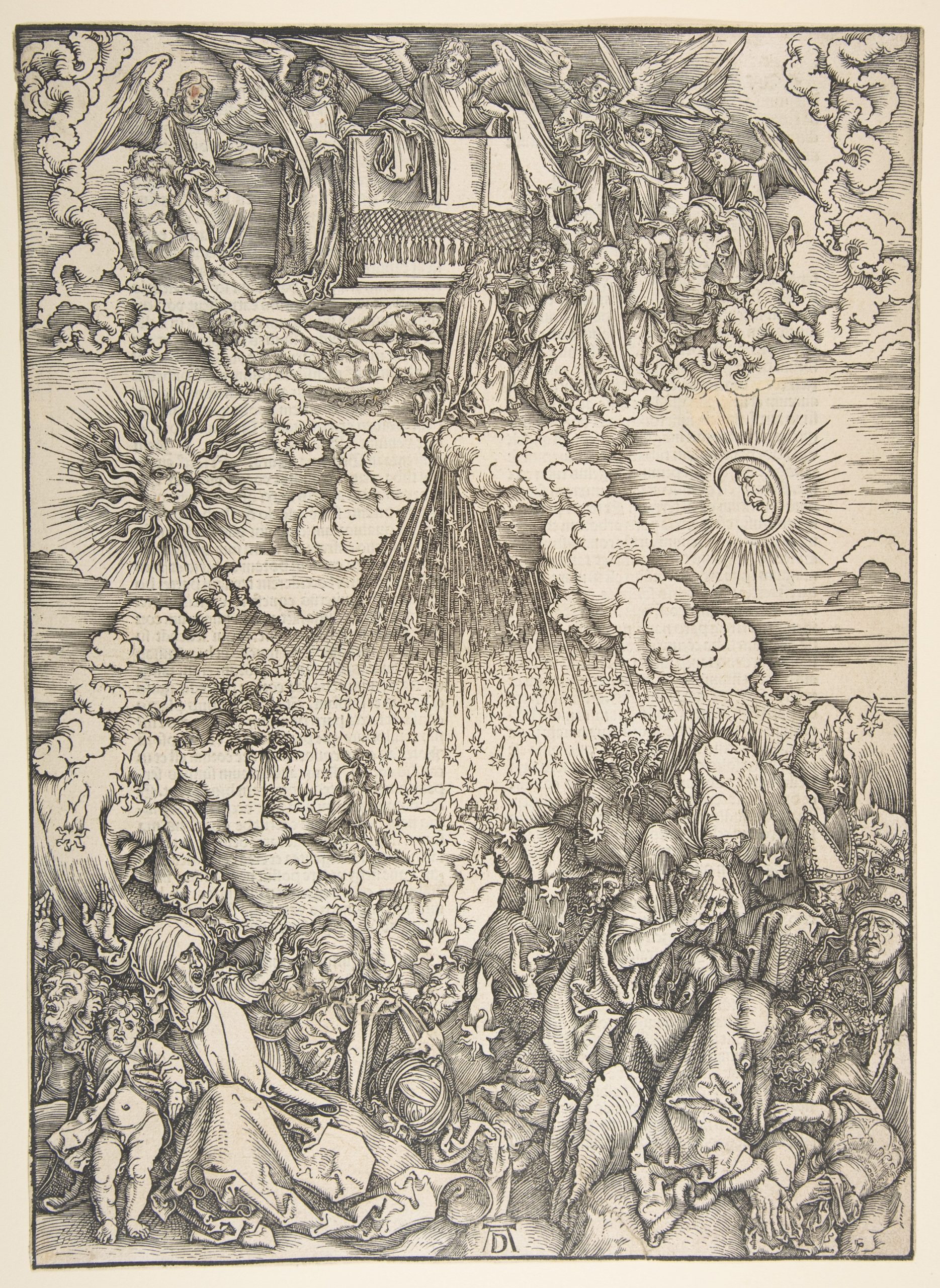
Courtesy: Gift of Mrs. Felix M. Warburg, 1940. “https://www.metmuseum.org/art/collection/search/397058” is licensed under CC0 1.0.
To view the series of Apocalypse wood cut art images created by Albrecht Durer, please open the links here and here.
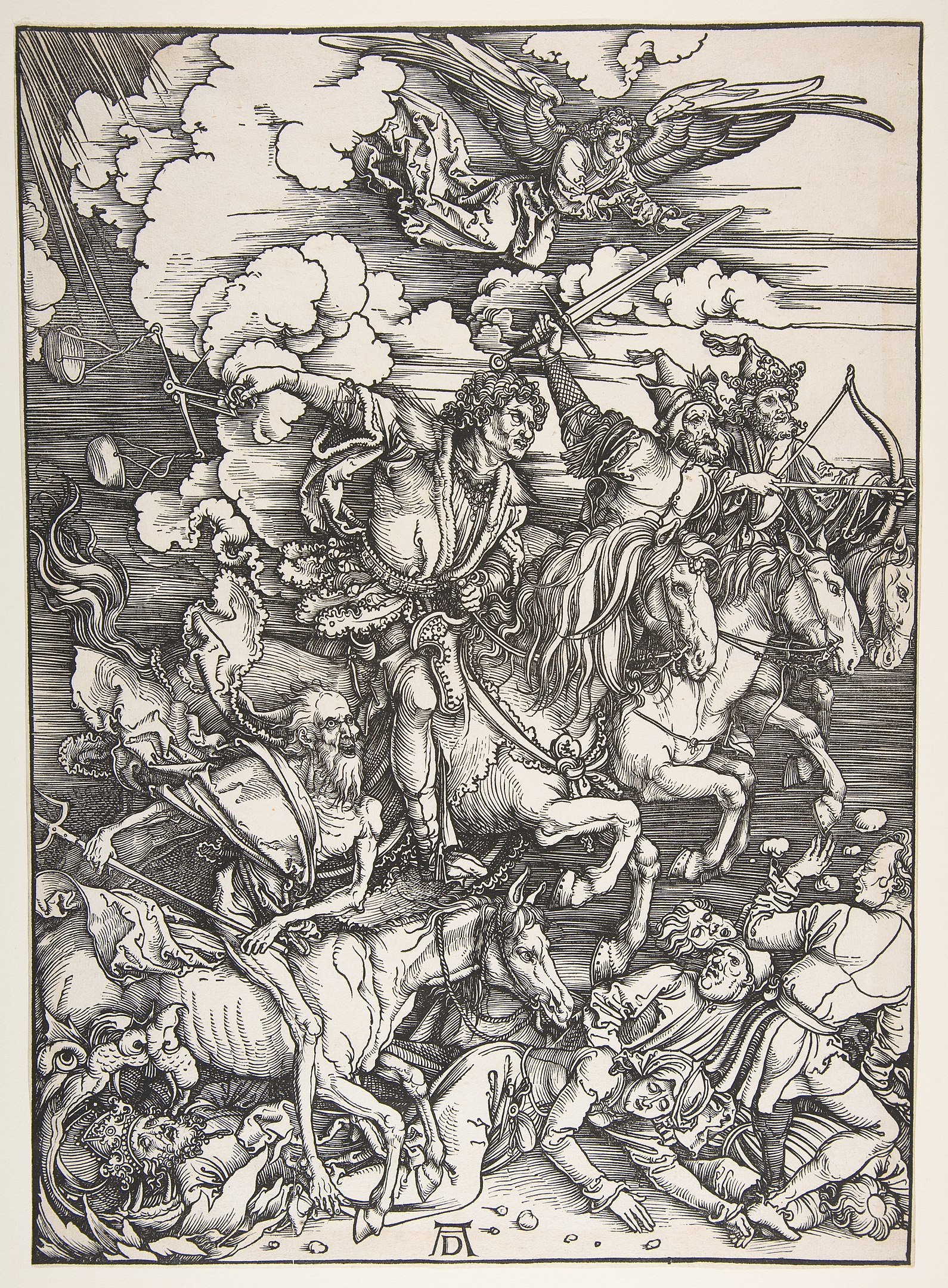
Courtesy: Gift of Junius Spencer Morgan, 1919. “https://www.metmuseum.org/art/collection/search/336215” is licensed under CC0 1.0.
“The third and most famous woodcut from Dürer’s series of illustrations for The Apocalypse, the Four Horsemen presents a dramatically distilled version of the passage from the Book of Revelation (6:1–8): “And I saw, and behold, a white horse, and its rider had a bow; and a crown was given to him, and he went out conquering and to conquer. When he opened the second seal, I heard the second living creature say, ‘Come!’ And out came another horse, bright red; its rider was permitted to take peace from the earth, so that men should slay one another; and he was given a great sword. When he opened the third seal, I heard the third living creature say, ‘Come!’ And I saw, and behold, a black horse, and its rider had a balance in his hand; … When he opened the fourth seal, I heard the voice of the fourth living creature say, ‘Come!’ And I saw, and behold, a pale horse, and its rider’s name was Death, and Hades followed him; and they were given great power over a fourth of the earth; to kill with sword and with famine and with pestilence and by wild beasts of the earth.” Transforming what was a relatively staid and unthreatening image in earlier illustrated Bibles, Dürer injects motion and danger into this climactic moment through his subtle manipulation of the woodcut. The parallel lines across the image establish a basic middle tone against which the artist silhouettes and overlaps the powerful forms of the four horses and riders—from left to right, Death, Famine, War, and Plague (or Pestilence). Their volume and strong diagonal motion enhance the impact of the image, offering an eloquent demonstration of the masterful visual effects Dürer was able to create in this medium.” (Metropolitan Museum of Art, New York City).
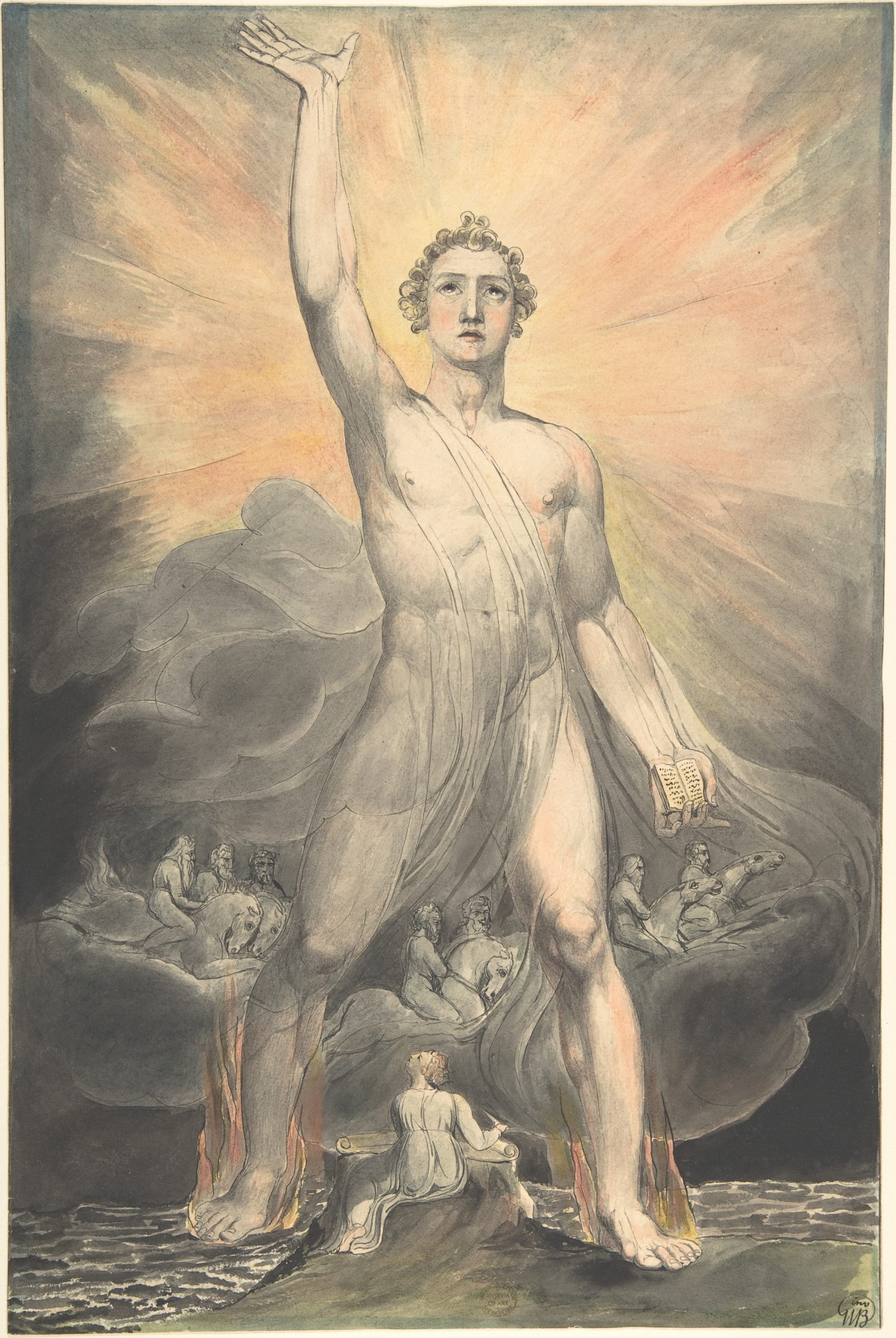
Courtesy: Rogers Fund, 1914. “https://www.metmuseum.org/art/collection/search/340852” is licensed under CC0 1.0.
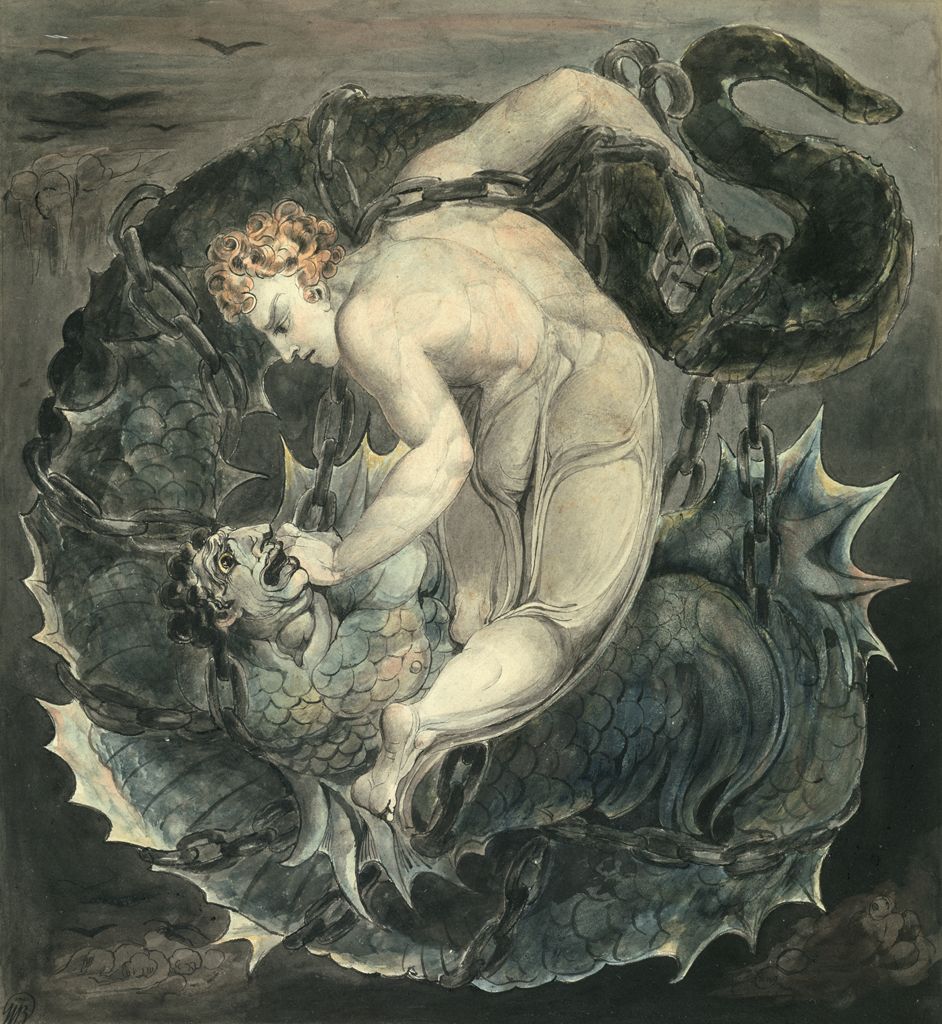
Courtesy: By William Blake – [1], Public Domain, https://commons.wikimedia.org/w/index.php?curid=65802550
“If the doors of perception were cleansed every thing would appear to man as it is, Infinite. For man has closed himself up, till he sees all things thro’ narrow chinks of his cavern”.-William Blake, The Marriage of Heaven and Hell
To view more illustrations by William Blake please open the links here and here.
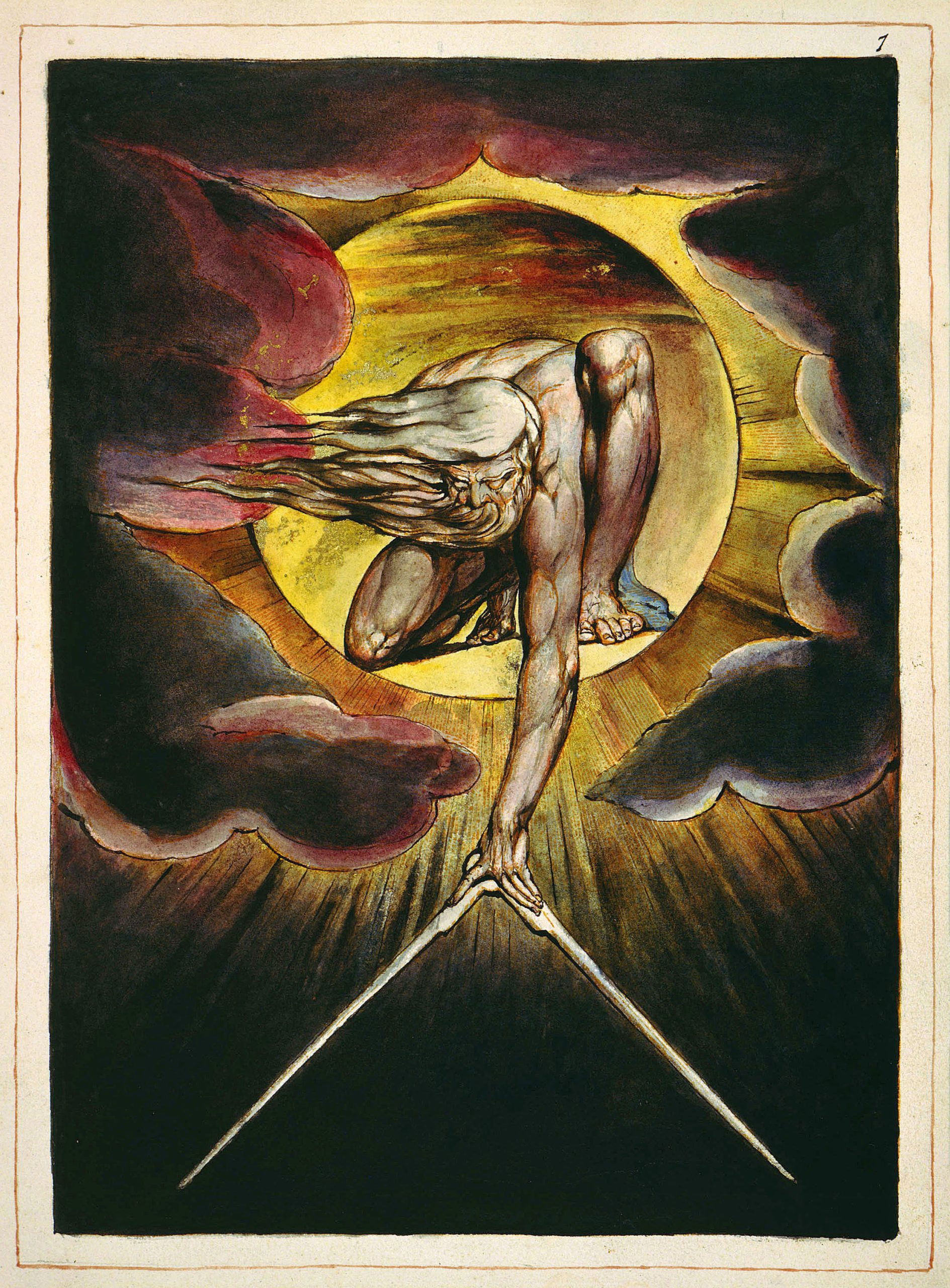
Courtesy: By William Blake – The William Blake Archive, Public Domain, https://commons.wikimedia.org/w/index.php?curid=8108385
“Europe: A Prophecy” by William Blake
Five windows light the cavern’d Man; thro’ one he breathes the air;
Thro’ one, hears music of the spheres; thro’ one, the eternal vine
Flourishes, that he may receive the grapes; thro’ one can look.
And see small portions of the eternal world that ever groweth;
Thro’ one, himself pass out what time he please, but he will not;
For stolen joys are sweet, & bread eaten in secret pleasant.
So sang a Fairy mocking as he sat on a streak’d Tulip,
Thinking none saw him: when he ceas’d I started from the trees!
And caught him in my hat as boys knock down a butterfly.
How know you this said I small Sir? where did you learn this song?
Seeing himself in my possession thus he answered me:
My master, I am yours. command me, for I must obey.
Then tell me, what is the material world, and is it dead?
He laughing answer’d: I will write a book on leaves of flowers,
If you will feed me on love-thoughts, & give me now and then
A cup of sparkling poetic fancies; so when I am tipsie,
I’ll sing to you to this soft lute; and shew you all alive
The world, when every particle of dust breathes forth its joy.
I took him home in my warm bosom: as we went along
Wild flowers I gatherd; & he shew’d me each eternal flower:
He laugh’d aloud to see them whimper because they were pluck’d.
They hover’d round me like a cloud of incense: when I came
Into my parlour and sat down, and took my pen to write:
My Fairy sat upon the table, and dictated EUROPE.
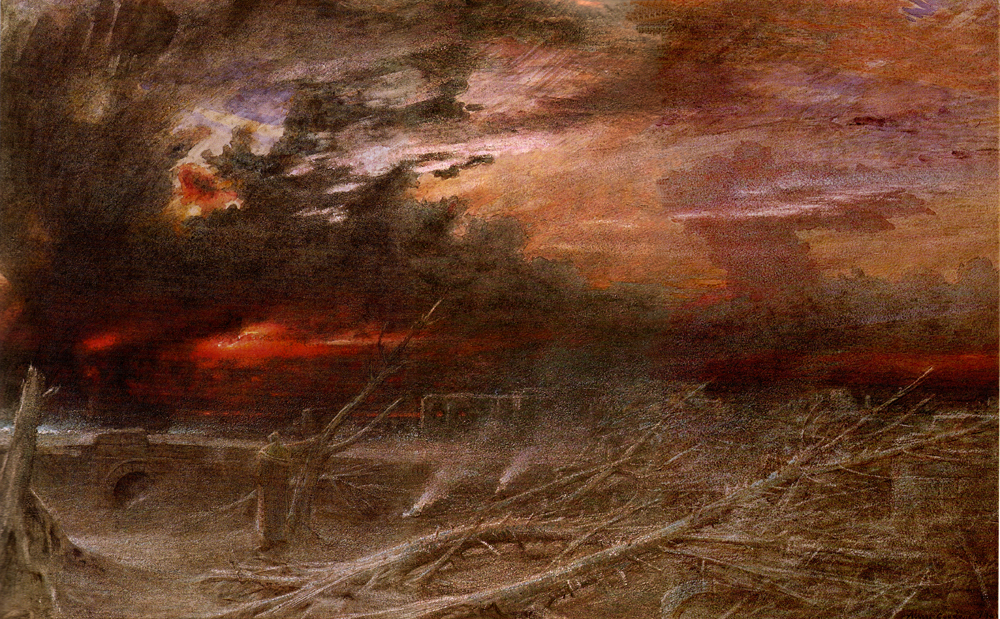
Courtesy: By Albert Goodwin – http://www.artrenewal.org/artwork/154/3154/32410/apocalypse-large.jpg, Public Domain, https://commons.wikimedia.org/w/index.php?curid=17090743
“Fire and Ice” By Robert Frost
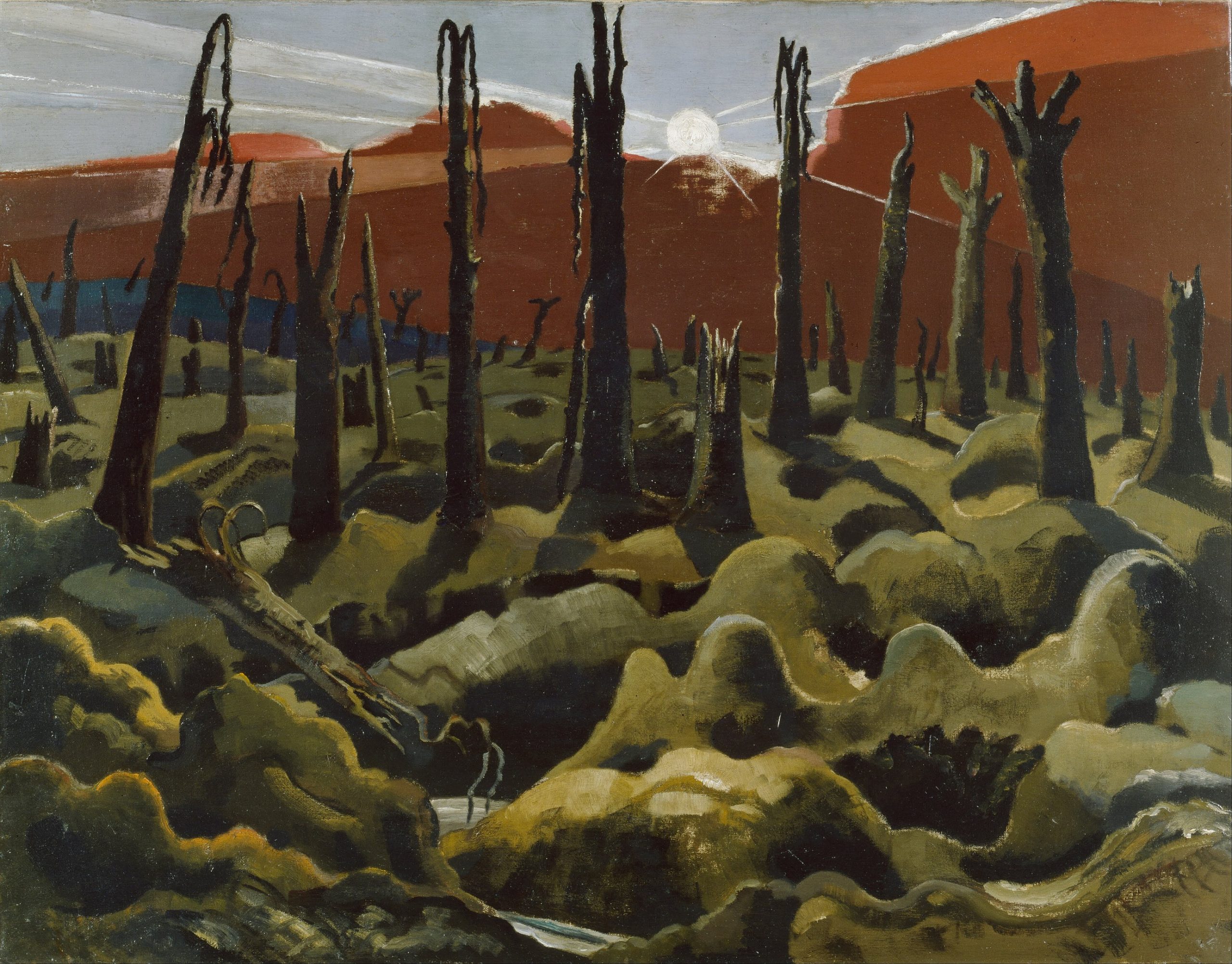
Courtesy: By Paul Nash – Google Arts & Culture: Home – pic Maximum resolution., Public Domain, https://commons.wikimedia.org/w/index.php?curid=76558181
“The Trees’ Counselling” by Christina Georgina Rossetti
Thro’ the corn fields and the meadows;
The stream sounded melancholy,
And I walked among the shadows;
While the ancient forest trees
Talked together in the breeze;
In the breeze that waved and blew them,
With a strange weird rustle thro’ them.Said the oak unto the others
In a leafy voice and pleasant:
“Here we all are equal brothers,
“Here we have nor lord nor peasant.
“Summer, Autumn, Winter, Spring,
“Pass in happy following.
“Little winds may whistle by us,
“Little birds may overfly us;“But the sun still waits in heaven
“To look down on us in splendour;
“When he goes the moon is given,
“Full of rays that he doth lend her:
“And tho’ sometimes in the night
“Mists may hide her from our sight,
“She comes out in the calm weather,
“With the glorious stars together.”From the fruitage, from the blossom,
From the trees came no denying;
Then my heart said in my bosom:
“Wherefore art thou sad and sighing?
“Learn contentment from this wood
“That proclaimeth all states good;
“Go not from it as it found thee;
“Turn thyself and gaze around thee.”And I turned: behold the shading
But showed forth the light more clearly;
The wild bees were honey-lading;
The stream sounded hushing merely,
And the wind not murmuring
Seemed, but gently whispering:
“Get thee patience; and thy spirit
“Shall discern in all things merit.”
Artists’ Images of War and Destruction
Paul Nash painted “We are making a new world” in 1918, the start of World War I. What message about war and the natural environment is Nash making? Nash’s painting has been compared to Pablo Picasso’s Guernica (to view the image, please open the link below). How do the messages from these paintings resonate with global war and conflict in more recent times?
To read more about the 1937 painting “Guernica” by Pablo Picasso (1871-1973), please open the links here. and here.
Pablo Picasso (1871-1973): To read more about the artist Pablo Picasso please open the link here.
For more information about the Paul Nash (1889-1946) “We are making a new world” please open the please open the link here. and here.
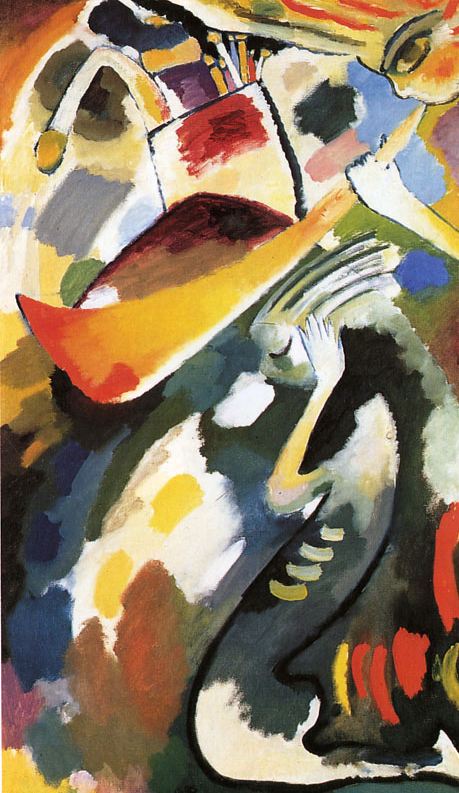
Courtesy: By Wassily Kandinsky – http://www.wassilykandinsky.ru/work-469.php, Public Domain, https://commons.wikimedia.org/w/index.php?curid=67453496

